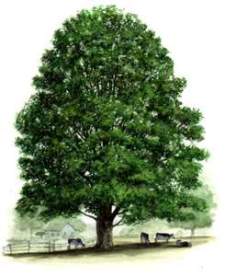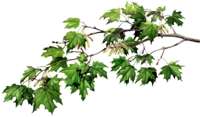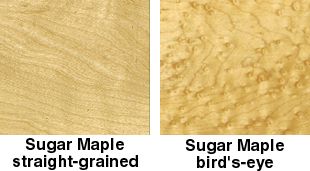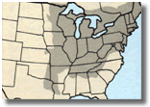
 Sugar Maple
Sugar Maple
Hard as a rock, but how sweet it is!
Acer, part of the maple family's latin, scientific name, means hard or sharp. And to the Romans, the wood was just that. From it, they made lance and pike shafts for battle. It was furniture, though, that bestowed the term "rock hard" on this traditional stock.
As the story goes, a colonial American cabinetmaker by the name of Rock promoted his work as "Rock's Hard Maple Furniture." That's why to this day many people refer to sugar maple as rock or rock-hard maple.
Sugar maple, although tough as its reputation, has a sweeter side. The other half of its genus name saccharum refers to its sap, a source of syrup and sugar.
 Wood
identification
Wood
identification
Practically all states east of the Great Plains boast sugar maple (Acer saccharum), that in a forest setting, grows 70-130' tall with a diameter of 2-3'. Open-grown trees have shorter trunks with a rounded crown of many branches. All sugar maples when young have a smooth silvery bark that with age turns ash-gray and breaks into unevenly layered flakes or scales.
Sugar maple has palm-sized leaves with five pointed lobes that in the fall call forth brilliant shades of red and orange. In early summer, double-winged keys the tree's inedible fruit emerge.
Straight-grained, fine-textured, hard, strong, and at 44 pounds per cubic foot as heavy as red oak, the wood of sugar maple has high commercial value. Its sapwood, frequently 3-5" thick, appears much lighter in color than the slightly pinkish-tan heartwood. Both are sold.
Some trees produce spectacularly figured wood in curly, fiddleback, quilt, and bird's-eye.
Known for its toughness and durability, sugar maple takes a pounding as bowling-lane surfaces, bowling pins, school desks, tool handles, and ladder rungs. On a gentler side, it's sugar maple that becomes much of the furniture we call "Early American." The wood also shows up as cabinets, countertops, cutting boards, butcher block, and flooring.
Turners find figured sugar maple, particularly burls and intricately colored spalted stock, appealing for bowls. Fiddleback sugar maple has always been popular for the backs of stringed instruments, such as violins.
 AvailabiIity
AvailabiIity
Sugar maple, sold all across the continent, often comes in board lengths of 12' and widths to 10". Large dealers may also offer figured wood as well as plain lumber. And, furniture squares, hardwood plywood, and figured veneers are easily obtained.
In abundant supply, sugar maple lumber sells for about $1.50 per board foot (slightly more for figured stock). Veneer, from plain to exquisitely figured, costs from 50 cents to $1 per square foot.
Sugar maple isn't dubbed "hard maple" without reason. It dulls cutting edges, yet it chips. And, sugar maple burns more easily from cutting and machining than any other wood. Here's how to overcome this wood's pesky traits:
|
|
|